Blogs
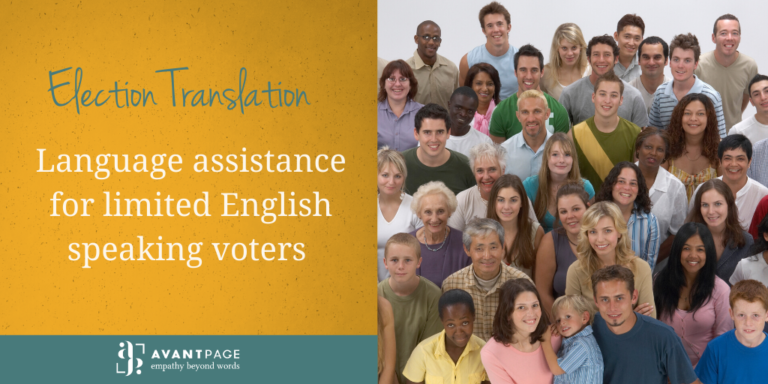
Election Translation [Language Assistance for Limited-English Speaking Voters]
As Americans settle into the new reality of life under shelter-in-place directives, questions abound about how and when life will return to normal. When will I next sit down at a favorite restaurant? When will I board a plane again? Will my kids be returning to the classroom in 2020? Not least of these questions - how will I vote when November rolls around? This is a question very much on our minds at Avantpage. With our mission of empowering immigrant populations through language access, we worry about the impact of a changed election process on limited English speaking populations. With elections partners in Washington, California, New York, and Florida, we see different barriers affecting teams around the country. In our home state of California, we are already witnessing an increase in vote by mail (VBM), as a number of counties implemented the Voters Choice Act in 2016 and 2018. The shift in those counties from polling stations to Vote Centers aimed to make voting more convenient and flexible, expanding early voting and ensuring that every eligible voter received a mail-in ballot. This makes California more prepared than some for a shift to remote voting, but we are far from ready to implement this model across the entire state. From the translation standpoint, Avantpage is in conversation with county officials, and looks forward to more information on the following areas. Voter outreach
How do states and counties plan to adequately inform LEP citizens of changes to voting? This could be in written form, but are there also plans to provide in-language TV ads, public service announcements, and radio segments? Avantpage is seeing increased demand for these alternative language services and is well positioned to help in a variety of media. File types
Will a broader range of ballot types require translation, to accommodate remote voting? This is a great thing to add to your planning process, as well as the time required to reformat after translation and to potentially print and mail a higher number of ballots and voter guides than normal. Funding
Will budgets be adjusted to allow for increased mailing of foreign language ballots? As always, working with your translation provider to streamline processes and identify areas for cost savings is key. After translation, Avantpage provides customized breakdowns of spend that allow counties to bill candidates as needed. Our advanced reporting could be useful for emergency funding or other financial purposes in light of these exceptional circumstances. Planning
We know that elections teams are inundated with work. An election period is busy enough, without the uncertainty and reorganization required during this pandemic. We can not stress enough the importance of planning and keeping your providers in the loop. Avantpage encourages team meetings as early as possible and looks forward to contributing ideas and best practices at this time. If you're looking for help creating a translation plan for the upcoming election, please fill out our Contact Us Form, or email [email protected]
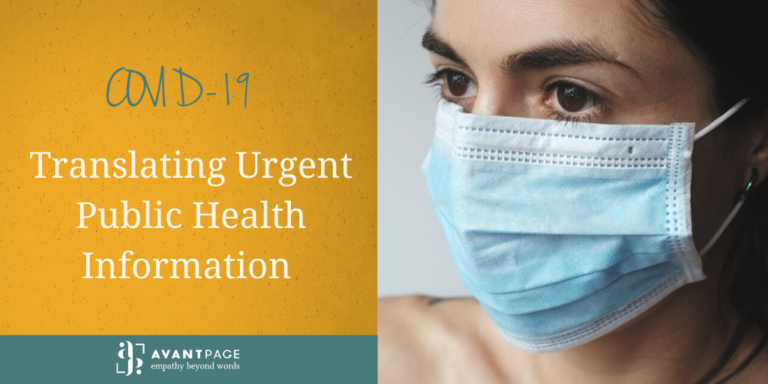
COVID-19 - Translating Urgent Public Health Information
As the COVID-19 public health crisis sweeps across the globe, organizations of all types find themselves needing to communicate urgent messaging at unprecedented rates. Whether it’s patient information, school notices, election postponements, or workplace health and safety practices, digital communication is an essential tool in the fight to contain the novel Coronavirus. And with huge portions of the population under shelter-in-place directives, accessible, culturally-appropriate, and timely communication is as important as ever for immigrant and LEP communities. Public agencies and healthcare organizations likely have partnerships in place for translating this COVID-19 related messaging. For those new to translation, the thought of creating a localization program from scratch at a time like this is understandably daunting. With so many moving parts to the communications process and a huge volume of frequent updates, there is a risk that translation will fall to already overburdened bilingual employees. It may be handled through ad-hoc and disjointed requests to multiple LSPs (Language Services Providers). Worse still, it may not happen at all, leaving limited-English speakers with an information gap that could prove disastrous. The good news is that the challenge is by no means insurmountable. In fact, the written translation industry is already well situated to adapt to a 100% remote working model without any interruption to business operations. The tools and technologies available mean that accurate, consistent translation is achievable in a very short amount of time. The right translation partner will take the pressure off your staff and ensure that communications are clear and accessible. Now is the time to rely on that partner for an efficient process. Avantpage has identified six areas of concern, with simple solutions for your team. Terminology management
Inconsistent terminology leads to confusion at a time when clear messaging is essential. Ask your LSP if they have built COVID-19 glossaries in your threshold languages. This should be used by their translators and your reviewers, if you have an internal review process in place. Using Translation Memory (a database of previously-translated content) also provides this consistency and greatly shortens delivery by reusing text from previous projects. Centralization
Take a moment to look at your translation request process. If your teams are making requests ad hoc, they may be using different LSPs or individual translators, resulting in duplicated efforts and inconsistencies. Consider centralizing through one person/team, and ask your LSP about best practices. Avantpage offers free consultation in this area. Turnaround Times
Ask your LSP how they are shortening delivery cycles and processing after-hours requests/deliveries. Be sure that your teams understand the different options and associated costs, and consult with your vendor on best practices to ensure streamlined processing. This streamlining is essential not only during COVID-19, but for all of your translation needs. Bilingual Employees
Now more than ever is the time to recognize the pitfalls of relying on bilingual employees. With teams working from home and handling increased workloads, be sure you have an external solution that you can trust for your multilingual messaging. LSPs have access to linguistic assets and specialist tools not always available to your staff members. Safe handling of PHI
If you handle sensitive data or private health information (PHI), then your LSP should already comply with regulations such as HIPAA (Health Information Portability and Accountability Act). Now is no exception. If you are concerned about this, ask how they are ensuring compliance while their teams work remotely. Reporting
It may not seem a priority now, but in the future you may want to see separate or comparison reporting for COVID and non-COVID translation projects. This helps plan for future situations, and, depending on your emergency funding, could help with grants or other financial programs. Ask your LSP if they are storing this information and will be able to provide reports now or at a later point. Your team is working harder than ever to fulfill their roles while adjusting to new work environments, scheduling increased video calls, and juggling family responsibilities. Not to mention keeping themselves safe and well at this time. By asking the right questions when it comes to translation, you’ll ensure they have one less thing to worry about. Working with the right LSP will improve your process and your messaging. And improved messaging keeps your LEP community safe and informed. If you are looking for more information about the translation process, or need multilingual messaging now, please visit our website or contact [email protected].

Looking for a New Language Service Provider? These 5 Questions Will Help
Whether you’re starting a new translation journey, or you’re a seasoned veteran, finding the right Language Service Provider (LSP) who can meet your organization’s needs is key. When you’re in search of a partner for your language service needs, you need to be sure that the LSP you’re reaching out to will be able to reach your target audience(s) effectively. There are a few key questions that can help you determine if the LSP you’re thinking of partnering with is the right LSP for your organization. What industries do you work with?
Many industries are regulated for translation. If you’re in one of those industries, it’s likely that your potential LSP has experience in the industry. However, part of choosing a partner is ensuring they have the experience to translate documents for your industry effectively. What are your standard turnaround times? How are rush projects handled?
Knowing the process of submitting a language project to your LSP can help you to plan ahead and be sure you’re prepared to work on a timeline that is appropriate for both your organization and your LSP. Having prior knowledge of turnaround times and rush projects can assist in ensuring that your language projects are completed on time, and that you’re submitting documents on a proper timeline. What languages do you work with?
If your LSP doesn’t work within your target language, they aren’t the right LSP for your organization. Identify which languages you’ll need language services for, and be sure to partner with an LSP who works with those languages and dialects. What technologies do you leverage to make translation projects more successful?
Working with an LSP who uses language technologies like Translation Memory, and linguistic assets like style guides and glossaries, can help to ensure that your documents are translated consistently over time. Additionally, these technologies help to save your organization time and money in the long run. Who will be on my translation team?
You should be aware of all the people that will have their hands on your language projects. From account managers and project managers, to translators and quality analysts. Ask about how translators are tested to work with the LSP and be sure that you’re comfortable with the process of how your LSP handles language projects. If you’re looking for a new LSP, we can help! Give us a call at 530-750-2040, and we can walk you through our language service offerings. Or, if you’re ready to start a new translation project, request a free quote today.

These 4 Industries Benefit From Language Services
While there are many industries that are regulated for language services, even those that aren’t can benefit from language projects. The language services industry continues to grow as more organizations recognize the need to translate, localize, or format their content for their Limited English Proficient (LEP) audiences. These industries aren’t regulated for translation, but they benefit from it all the same. Marketing, advertising, and PR
Are you trying to break into a new market? Perhaps you’re thinking of taking your organization global? If so, you’ll want to look into translating or localizing your marketing, advertising, and PR content. The key to reaching new audiences is ensuring that your target audience can fully understand your product or service, and how it benefits them. Translating or localizing your marketing content can make all the difference when it comes to selling products or services to a new language market. Technology
The technology boom continues on, and language services greatly benefit your technology organization. If you’re looking to increase the availability of your services to a global audience, or you want to bring on more qualified candidates, translating your content can help you to achieve either. More LEP and non-English speaking organizations are likely to contract your technology services, and more qualified candidates will be able to apply for your open positions. Tourism
If your hotel or other travel organization is located in a tourist destination, language services can help you to acquire more customers. Localizing or translating your website, booking information, and other related content can help tourists to better understand what you’re offering, and make them more likely to engage with the services you offer. Banking and finance
Banking and finance organizations can benefit from language services to help ensure clear and accurate messaging to all. If your financial organization works with multinational organizations, LEP populations, or non-English speaking populations, translating your messaging helps to ensure that your terms, expectations, and more are clear to those who are engaged in business with you. If you don’t see your organization on this list, your industry will still benefit from language services! These services can offer clarity to LEP and non-English speaking populations, while also attracting more customers or clients to your organization. If you want to discuss the benefits of translation for your industry, call us at 530-750-2040. If you’re ready to start your next translation project, request a free quote today.

Your Top Tips for Translating Your Elearning Content
Elearning. It’s not just found at .edu websites. The industry is growing rapidly both in the education and corporate worlds. As the world increasingly turns to digital solutions, more students are finding it convenient to complete their courses of study online, just as more organizations are looking for cost-effective ways to complete their employees’ training requirements. This trend has also opened up a new need - Elearning translation. As more programs become available for students and workers, it’s imperative that all have equal access to these online learning opportunities, and that includes Limited English Proficient (LEP) students. If you’re looking to increase the availability of your Elearning courses, there are many different language services that can help. Localizing your Elearning content from end-to-end can exceptionally increase the accessibility of your online learning platform. Localization will ensure that all of your content reads, looks, and feels as though it was originally created in the target language. All of your graphics, colors, and text will be adjusted to ensure that your LEP students can effectively interact with your learning platform. Translating your Elearning content will ensure that the text provided to your students is understandable. Not only will this increase the number of students that will pursue learning on your platform, but those students will also be more able to engage with your written content on your learning platform. Elearning translation projects can open up education opportunities to students that wouldn’t otherwise have them if your organization doesn’t have the time or ability to start a localization project. Video captioning is another option for your Elearning platform. If your platform uses a variety of videos to engage your learners, providing captions in your target languages can help LEP students to more effectively understand the content. Easier than creating the same video in multiple languages, video captioning can help your students to learn the material and can help you to garner more interest in your program as a whole. There are many different documents, forms, and types of content that your organization may want to translate, localize, or caption. Some of these documents and content include: IN EDUCATION: IN THE PRIVATE SECTOR: The more content that your organization has undergo Elearning translation, the more LEP students and employees your online learning platform will serve. Not only is this positive for the students, as they’ll be better able to understand and learn from your platform, but this is also positive for your organization. By serving more LEP learners in-language, you can help to increase your social image, increase the desirability of your programs, and more. If you want to get started on your next Elearning translation project, we can help. Call us at 530-750-2040, or request a free quote today. GET VALUABLE CONTENT DELIVERED STRAIGHT TO YOUR INBOX. SIGN UP FOR OUR NEWSLETTER TODAY!
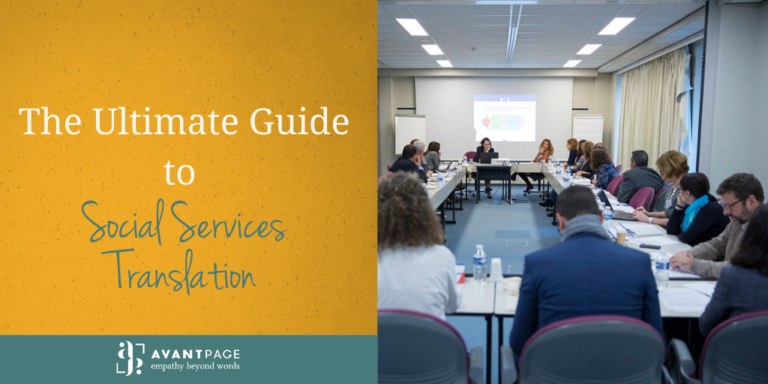
The Ultimate Guide to Social Services Translation
Social Services professionals are in a unique position to provide support to a variety of populations. Whether planning nutritional programs, after school programs, or coordinating family planning - Limited English Proficient (LEP) populations are touched by your work on a regular basis. Social Services translation helps to bridge the gap between what you’re offering and the populations that need your services. All government-funded entities are regulated for translation, but the specific documents that must be translated are not referenced by regulations like Title VI and Executive Order 13166. The decision as to what documents must be translated for each office is individual to a point, but translating key documents across all social service providers can increase the ability for all to access the vital resources you offer. A vital document is one that contains critical information that needs to be understood in order for an LEP person to fully engage with the services you’re offering. These vital documents include, but are not limited to: If your native audience has access to the information and needs to fully understand it in order to actively participate in your programs, your LEP audience needs to have the same access. There are other social service translation projects that your organization should consider, outside of vital documents. Translating these documents can benefit your LEP populations and make them feel more included in your community. Other translation projects include, but are not limited to: These social services translation projects benefit your populations by making your programs accessible to all, but they also benefit your organization. Taking on these projects can increase the overall image of your organization, and the public’s satisfaction with your organization. If you want to get started on your next social services translation project, we can help! Call us at 530-750-2040 or request a free quote today.
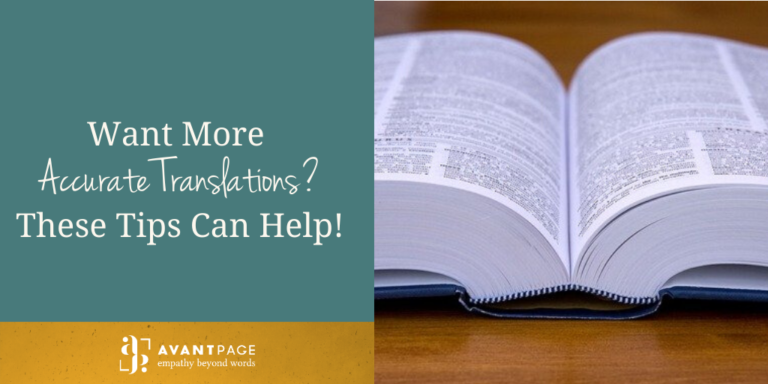
Want More Accurate Translations? These Tips Can Help!
There are many moving pieces to your language projects, from the language services your organization needs to the linguists completing your projects. The key to accurate translations is ensuring that all of these moving pieces are working in harmony with each other. Getting these pieces to work together effectively doesn’t have to be challenging, you just need to follow these steps to ensure accurate translations. Identify your target audience and target language Before you begin the process of translating or localizing your content, you need to know your target audience and what language they speak. If there are different dialects of that language, you should also be sure to know what dialect your audience uses. Once you’ve identified this information, you’ll want to pass it onto your Language Service Provider (LSP) so they can effectively translate your documents. If you don’t have this information, you can work with your LSP to determine the language and dialect used by your target audience. Complete your source document before sending for translation Part of ensuring high-quality and accurate translations is knowing that your final file is complete before you send it for translation or localization. When you send an in-progress file to you LSP, the process of translating or localizing your documents will be drawn-out. You’ll need to go back-and-forth with the document and its edits, and having your LSP translate each iteration of the document will make your project lengthier and more expensive. Openly communicate with your LSP Keep an active line of communication with your LSP. If you aren’t sure what language service you need, what kind of content would best reach your target audience, or if you have any other questions - your LSP is likely to have the answer. They can help to ensure accurate translations by answering all of your questions, leading you on the path towards the right language projects, and more. Provide context for your projects Be sure that your LSP knows the reason why you’re translating the documents you’ve chosen. When you provide context, your LSP can be sure that the documents will meet the needs of your end-user much more effectively. Particularly if you’re submitting similar projects on a consistent basis, having that context can help your LSP to build a template for your translation, decreasing time and money spent on your projects over time. If you’re interested in starting your next translation project with an LSP who ensures accurate translations, we can help. Call us at 530-750-2040, or request a free quote today.

What Do You Know About Transcreation?
If you’re looking to globalize your business, you may be asking yourself what language service will best achieve your goals. While literal translation will adapt your content to meet the language requirements of your target audience, it could lead to misnomers, given that most words have more than one meaning. Localization projects will adapt all aspects of your content to suit the needs of your target audience, but your content may not contain graphics, colors, and other stylistic elements generally adapted in full localization. This is where the service known as transcreation comes in. Transcreation is the practice of shaping a message in one language to best convey its original meaning in another. Transcreation preserves the original intent, context, emotion, and tone of the source document. Ideally, with a transcreation project, your target audience will have no idea that a transcreation occurred, the content will read as if it were originally created in the target language. There are many different situations in which transcreation is beneficial over translation, but it is predominantly used for creative, marketing-centric content. Marketing content tends to be regionally targeted, including slogans, idioms, and jokes that may not resonate with other cultures or languages. Transcreating your marketing messaging can help to ensure that you’re appropriately presenting your brand personality to your new target audience. The goal of a transcreation project is to re-interpret your original content into messaging that conveys the same idea or feeling to your target audience. Transcreation projects can help your marketing messaging to be more impactful, and help to launch your business on a more global scale. Interested in starting a new transcreation project, or learning more about transcreation? Call us at 530-750-2040, or request a free quote today.
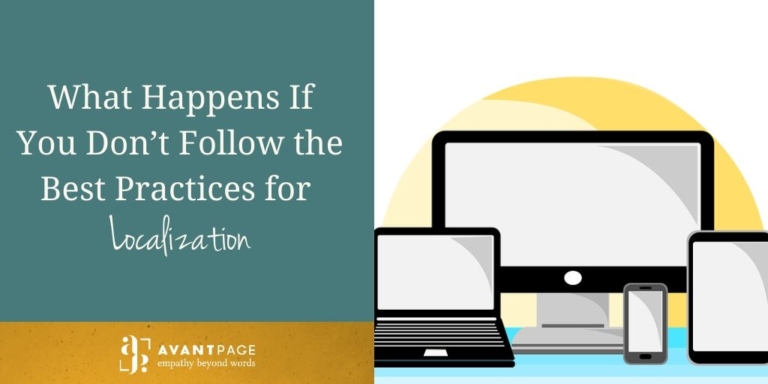
What Happens If You Don’t Follow the Best Practices for Localization
Localizing your content can help your organization to effectively reach new audiences. When you start a localization project, the many different aspects of your content that are adjusted allow your target audience to feel like your content was originally made for their language and culture. There are many ways that you can ensure your project goes smoothly, but if you don’t follow the best practices for localization you’ll find the project to be more challenging to complete. If you want a simple, easy process - you should absolutely avoid doing the following things! 1. Jump in without a plan
If you want your localization project to be completed on-time and in-budget, you need to plan your project beforehand. Know who will be involved, what content you want localized, who your target audience is, etc. Having this information before you start the project will help your Language Service Provider (LSP) to effectively localize the content for your new market. 2. Start your project without a style guide or glossary
Linguistic assets, like style guides and glossaries, streamline the localization process. They increase consistency throughout the project and allow your linguists to work within your organization’s preferences for all aspects of the project. The best practice for localization is to gather all of your linguistic assets and share them with your LSP before you start your localization project. 3. Write the source document in complicated language
If you really want to complicate your localization project, write the source document in complicated language. However, if you want your localization project to be easy for your organization and your LSP, following the best practices for localization means writing the source document following plain language principles. Also, stay aware of your target audience’s reading level, and write appropriately for that level. 4. Don’t provide your LSP with the original graphics
Withholding the original graphic files from your LSP will almost certainly increase the time your localization project takes. Part of your project is recreating graphics in a way that speaks to your target audience. If you want a much easier, shorter project, providing your LSP with the original graphics from your content is one of the best practices for localization. Small things add up to create longer project times and more challenging localization projects. If you want a streamlined, efficient project, you should work to follow the best practices for localization and avoid following the above advice. If you want more information, or to start your next localization project, call us at 530-750-2040 or request a free quote today.
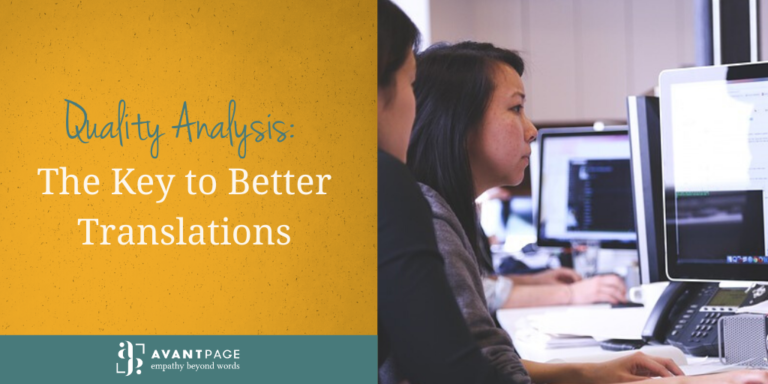
Quality Analysis: The Key to Better Translations
One lesser-discussed part of the translation process is that of quality analysis. While high-quality translations start with certified translators, they’re completed by a rigorous quality analysis process that allows your organization to have full confidence in the completed project. Once the translation or localization of your document is completed, it will need to be run through a quality analysis process. While this process will look different for each Language Service Provider (LSP), its foundation is the same across all LSPs. At the completion of a project, the quality analysis process helps to ensure that your translations are of the highest quality, and appropriately tailored to your target audience. While one translator, or a group of translators operating off of the same Translation Memory, will translate your original document, the process of ensuring quality demands bringing in an additional translator. This linguist’s sole job is to ensure that the translation is an accurate representation of what was written in the original text, with no spelling or grammar errors that would make the document challenging for your target audience to engage with. This process of Linguistic Quality Analysis (LQA) is a direct evaluation of your document and the translation that came from the original one. If any errors are found in the document, they are corrected before handing the final product off to your organization. LQA is one of many quality analysis processes that your LSP is likely to employ. If your document underwent formatting through Desktop Publishing (DTP), it will also need to undergo Design Quality Analysis (DQA). This process ensures that the formatting is appropriate after DTP, and that the document looks and feels as though it were originally written in the target language. This step is also of importance in the process of quality checking your localization projects, as localization projects are generally design-heavy. Finally, at Avantpage, we evaluate our linguists for each project they do - each of our linguists goes through their own quality analysis process. There are many criteria that we evaluate them on - from their language skills to their deadline compliance. This helps us to ensure that we’re working with linguists who can provide your organization with the best possible translations for your end-users. Quality analysis processes are an important part of translation projects, and you should partner with an LSP who takes them seriously. If you’d like to get started on your next translation project with quality in mind, call us at 530-750-2040 or request a free quote today.
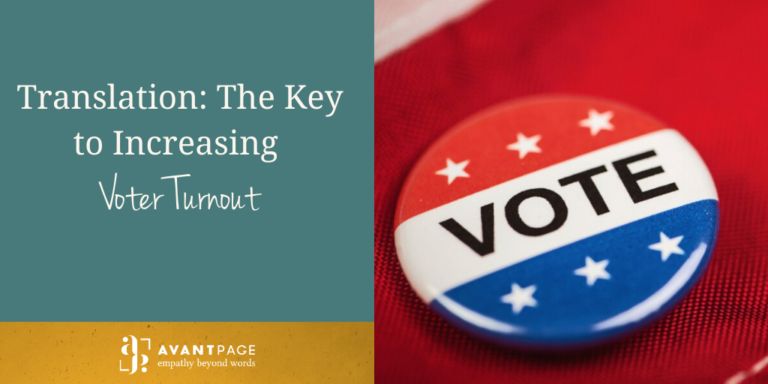
Translation: The Key to Increasing Voter Turnout
As the 2020 election draws near, voter turnout is top-of-mind for election professionals. Increasing voter turnout, particularly in your Limited English Proficient (LEP) communities, should be one of the top goals of your county. Regardless of your threshold languages, translation services can help to improve voter turnout in your county. There are many ways that translating your documents leads to increased voter turnout come election day. Prominently, translating your documents allows your LEP community members to fully understand who and what they are voting for. When people have a deep understanding of the ballot measures, candidates, and voting processes, they are more likely to participate in an election. Beyond this, translation allows LEP community members to feel like they are a part of the democratic process. When counties and candidates translate their election materials, LEP community members feel as though they are cared for. They are also more likely to feel as though their community cares about their voice and what they have to say. Creating an environment like this for LEP populations can lead to increase LEP voter turnout at the polls come election day. Increased voter turnout also occurs through translation due to a simplified voting process. When all of your county, including LEP community members, understand how the voting process works, they’re more likely to turn out to vote. Part of this is ensuring that your community members know what they need to bring in order to vote, what materials will be available, and what support will be available when they arrive at the polling place. Interpretation services can also increase voter turnout in your community. If your community members need help with instructions at the poll, having bilingual staff or community members volunteering at the polls can help. Making the process of voting easier by supporting your community will increase voter turnout as a whole. If you want to translate your documents to help increase voter turnout in your county, we can help. Call us at 530-750-2040 or request a free quote today to get started on your next election translation project.

Are You Working With Certified Translators?
As your organization looks into translation projects, it’s important to ensure that you have the proper people translating your documents. While machine translation may seem appealing and quick, and using your bilingual employees may seem like it saves you time and money, neither are ideal if you want accurate, high-quality translations. Partnering with a Language Service Provider (LSP) gives you access to qualified and certified translators who will be able to effectively translate your documents and reach your target audience. A certified translator is a linguist who has passed an exam that assesses their ability to accurately translate from one language into another. There are three main organizations that certify translators in the US: There are other organizations that provide certification for translators as well, but these three organizations are the most well-recognized in the language industry. The process of becoming a certified translator involves a series of tests, as well as a track record of success in translation projects. If you want to be sure that your translations will be beneficial to your end-users, working with certified translators can definitely help. You can have confidence that your translation team has a proven track record of providing excellent translations, as well as a proven knowledge of both your source and target languages. Pairing with an LSP gives you access to a host of certified translators specializing in a variety of languages and domains. If you need your healthcare documents translated, an LSP will have a certified translator available with relevant experience in the healthcare domain to translate your documents. Having certified translators available for your translation projects can make the difference between a high-quality translation and a translation that does not reach your target audience effectively. If you’d like to get started on your next translation project with certified, qualified translators, we can help. Call us at 530-750-2040 or request a free quote today.